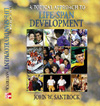 |  Life-Span Development: A Topical Approach John W. Santrock
Socioemotional Processes and Development Emotional Development
Learning Objectives1.Explore the involvement of physical arousal and overt behavior in emotions, noting that emotions can be classified in terms of positive or negative affectivity, then consider that:- emotion plays an important role in relationships, such as parent-child and peer relationships.
- the ability to regulate emotions is increasingly recognized as an important aspect of development.
- there is increasing interest in the concept of emotional intelligence.
|
 |  |  | 2.Describe the development of emotion, including:- Izard's coding of infant emotions (MAX), which demonstrates the presence of interest, distress and disgust at birth, and other emotions that appear in infancy
- the importance of crying, smiling, and stranger anxiety in emotional development during infancy
- preschoolers' increasing facility to talk about emotions
- the increasingly sophisticated ways of handling emotions in middle and late childhood, such as understanding what leads up to emotional reactions, and the ability to suppress, conceal, and redirect emotions
- the emotional highs and lows during adolescence
- Carstensen's socioemotional selectivity theory to explain developmental changes in emotion during adulthood, and how knowledge-related and emotion-related goals change across the life span
|
 |  |  | 3.Discuss depression and suicide in childhood, adolescence, and adulthood, noting that:- with respect to depression over the life span:
- the wider range of behaviors of childhood depression makes it more difficult to diagnose.
- parents' depression is linked with children's adjustment problems.
- adolescents have a higher rate of depression than children.
- female adolescents and adults are more likely to be depressed than males.
- depression may decrease in older adults.
- with respect to suicide:
- adolescent suicide rates in the United States have tripled since the 1950s.
- both proximal and distal factors are often involved in suicide.
- suicide increases by as much as three times in individuals 65 years and older.
|
 |  |  | 4.Explain how Chess and Thomas classified infants as easy, difficulty, and slow-to-warm-up, but more recent classifications focus on positive affect and approach, negative affectivity, and effortful control, while the notion of goodness of fit suggests that caregivers should be sensitive to individual characteristics of the child, be flexible in responding to these characteristics, and avoid negative labeling of the child. |
 |  |  | 5.Describe the importance of attachment in infancy and childhood, considering:- contact comfort and trust, not feeding, are important aspects of attachment
- the research of Bowlby, who described four phases in developing attachment, and Ainsworth, who described secure attachment as optimal but three types of insecure attachment (avoidant, resistant, and disorganized)
- the importance of caregivers being sensitive to the babies' signals and available to need their needs
- criticisms of attachment theory that suggest not enough attention is given to genetics, temperament, and the diversity of social agents and context, noting the cultural variations that have been found
- differences between mothers' primary role and fathers' playfulness when interacting with babies
- the need for and controversies about day care
|
 |  |  | 6.Understand the links between attachment and romantic relationships in adolescence, such as:- the effects of being securely attached (secure-autonomous) or insecurely attached (dismissing/avoidant, preoccupied/ambivalent, unresolved/disorganized)
- how dating or thinking about dating becomes important for adolescents, noting special concerns about early dating and developmental problems and the role that culture plays on dating
|
 |  |  | 7.Comprehend the relevance of attachment to love in adulthood and aging, including:- the categories of secure-autonomous, insecure-dismissing, and insecure-preoccupied as descriptions of adults' attachment
- the differentiation between romantic love and affectionate love, noting that romantic love tends to be more important in early adulthood, whereas affectionate love tends to be more important in later-life love relationships
|
|



 2002 McGraw-Hill Higher Education
2002 McGraw-Hill Higher Education